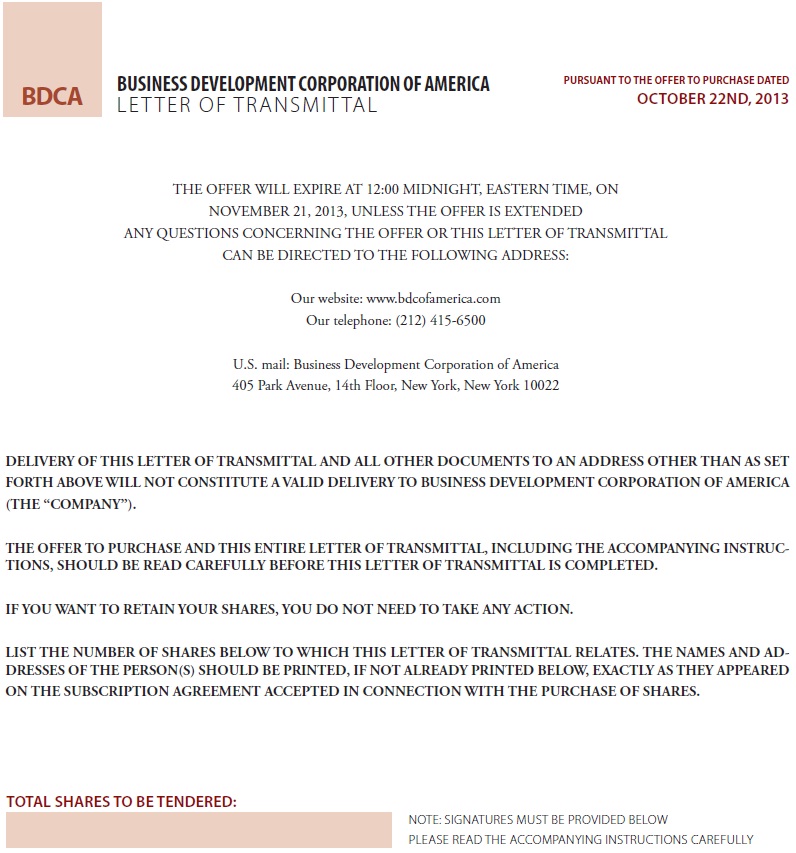
BDCA BUSINESS DEVELOPMENT CORPORATION OF AMERICA LET TER OF TRANSMIT TAL PURSUANT TO THE OFFER TO PURCHASE DATED OCTOBER 22ND, 2013 THE OFFER WILL EXPIRE AT 12:00 MIDNIGHT, EASTERN TIME, ON NOVEMBER 21, 2013, UNLESS THE OFFER IS EXTENDED ANY QUESTIONS CONCERNING THE OFFER OR THIS LETTER OF TRANSMITTAL CAN BE DIRECTED TO THE FOLLOWING ADDRESS: Our website: www.bdcofamerica.com Our telephone: (212) 415-6500 U.S. mail: Business Development Corporation of America 405 Park Avenue, 14th Floor, New York, New York 10022 DELIVERY OF THIS LETTER OF TRANSMITTAL AND ALL OTHER DOCUMENTS TO AN ADDRESS OTHER THAN AS SET FORTH ABOVE WILL NOT CONSTITUTE A VALID DELIVERY TO BUSINESS DEVELOPMENT CORPORATION OF AMERICA (THE “COMPANY”). THE OFFER TO PURCHASE AND THIS ENTIRE LETTER OF TRANSMITTAL, INCLUDING THE ACCOMPANYING INSTRUC-TIONS, SHOULD BE READ CAREFULLY BEFORE THIS LETTER OF TRANSMITTAL IS COMPLETED. IF YOU WANT TO RETAIN YOUR SHARES, YOU DO NOT NEED TO TAKE ANY ACTION. LIST THE NUMBER OF SHARES BELOW TO WHICH THIS LETTER OF TRANSMITTAL RELATES. THE NAMES AND AD-DRESSES OF THE PERSON(S) SHOULD BE PRINTED, IF NOT ALREADY PRINTED BELOW, EXACTLY AS THEY APPEARED ON THE SUBSCRIPTION AGREEMENT ACCEPTED IN CONNECTION WITH THE PURCHASE OF SHARES. TOTAL SHARES TO BE TENDERED: NOTE: SIGNATURES MUST BE PROVIDED BELOW PLEASE READ THE ACCOMPANYING INSTRUCTIONS CAREFULLY
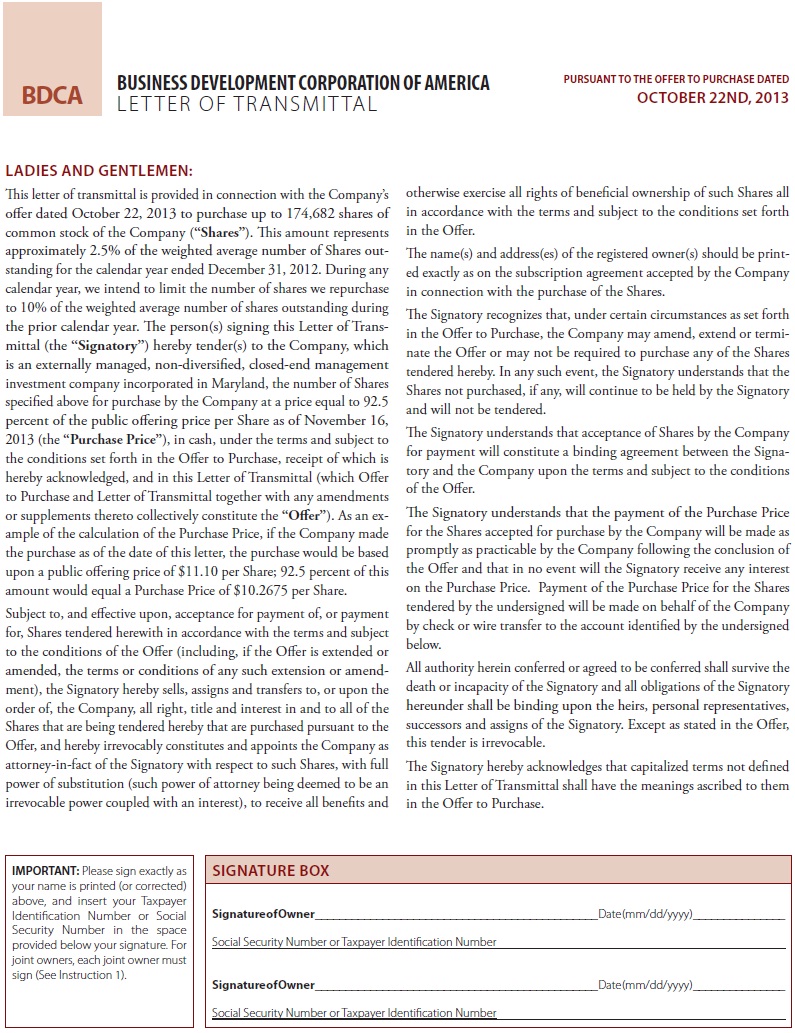
BDCA BUSINESS DEVELOPMENT CORPORATION OF AMERICA LET TER OF TRANSMIT TAL PURSUANT TO THE OFFER TO PURCHASE DATED OCTOBER 22ND, 2013 LADIES AND GENTLEMEN: This letter of transmittal is provided in connection with the Company’s offer dated October 22, 2013 to purchase up to 174,682 shares of common stock of the Company (“Shares”). This amount represents approximately 2.5% of the weighted average number of Shares out-standing for the calendar year ended December 31, 2012. During any calendar year, we intend to limit the number of shares we repurchase to 10% of the weighted average number of shares outstanding during the prior calendar year. The person(s) signing this Letter of Transmittal (the “Signatory”) hereby tender(s) to the Company, which is an externally managed, non-diversified, closed-end management investment company incorporated in Maryland, the number of Shares specified above for purchase by the Company at a price equal to 92.5 percent of the public offering price per Share as of November 16, 2013 (the “Purchase Price”), in cash, under the terms and subject to the conditions set forth in the Offer to Purchase, receipt of which is hereby acknowledged, and in this Letter of Transmittal (which Offer to Purchase and Letter of Transmittal together with any amendments or supplements thereto collectively constitute the “Offer”). As an ex-ample of the calculation of the Purchase Price, if the Company made the purchase as of the date of this letter, the purchase would be based upon a public offering price of $11.10 per Share; 92.5 percent of this amount would equal a Purchase Price of $10.2675 per Share. Subject to, and effective upon, acceptance for payment of, or payment for, Shares tendered herewith in accordance with the terms and subject to the conditions of the Offer (including, if the Offer is extended or amended, the terms or conditions of any such extension or amendment), the Signatory hereby sells, assigns and transfers to, or upon the order of, the Company, all right, title and interest in and to all of the Shares that are being tendered hereby that are purchased pursuant to the Offer, and hereby irrevocably constitutes and appoints the Company as attorney-in-fact of the Signatory with respect to such Shares, with full power of substitution (such power of attorney being deemed to be an irrevocable power coupled with an interest), to receive all benefits and otherwise exercise all rights of beneficial ownership of such Shares all in accordance with the terms and subject to the conditions set forth in the Offer. The name(s) and address(es) of the registered owner(s) should be printed exactly as on the subscription agreement accepted by the Company in connection with the purchase of the Shares. The Signatory recognizes that, under certain circumstances as set forth in the Offer to Purchase, the Company may amend, extend or terminate the Offer or may not be required to purchase any of the Shares tendered hereby. In any such event, the Signatory understands that the Shares not purchased, if any, will continue to be held by the Signatory and will not be tendered. The Signatory understands that acceptance of Shares by the Company for payment will constitute a binding agreement between the Signatory and the Company upon the terms and subject to the conditions of the Offer. The Signatory understands that the payment of the Purchase Price for the Shares accepted for purchase by the Company will be made as promptly as practicable by the Company following the conclusion of the Offer and that in no event will the Signatory receive any interest on the Purchase Price. Payment of the Purchase Price for the Shares tendered by the undersigned will be made on behalf of the Company by check or wire transfer to the account identified by the undersigned below. All authority herein conferred or agreed to be conferred shall survive the death or incapacity of the Signatory and all obligations of the Signatory hereunder shall be binding upon the heirs, personal representatives, successors and assigns of the Signatory. Except as stated in the Offer, this tender is irrevocable. The Signatory hereby acknowledges that capitalized terms not defined in this Letter of Transmittal shall have the meanings ascribed to them in the Offer to Purchase. IMPORTANT: Please sign exactly as your name is printed (or corrected) above, and insert your Taxpayer Identification Number or Social Security Number in the space provided below your signature. For joint owners, each joint owner must sign (See Instruction 1). SIGNATURE BOX SignatureofOwner Date(mm/dd/yyyy) Social Security Number or Taxpayer Identification Number SignatureofOwner Date(mm/dd/yyyy) Social Security Number or Taxpayer Identification Number
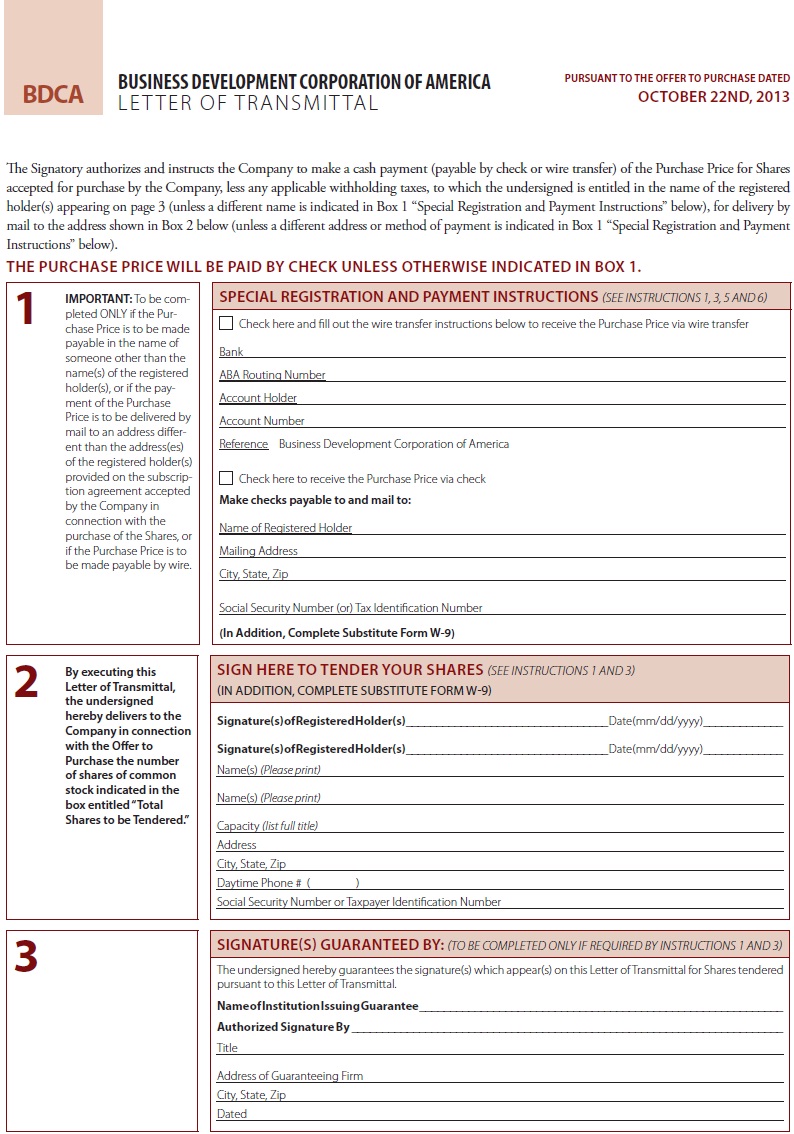
BDCA BUSINESS DEVELOPMENT CORPORATION OF AMERICA LET TER OF TRANSMIT TAL PURSUANT TO THE OFFER TO PURCHASE DATED OCTOBER 22ND, 2013 The Signatory authorizes and instructs the Company to make a cash payment (payable by check or wire transfer) of the Purchase Price for Shares accepted for purchase by the Company, less any applicable withholding taxes, to which the undersigned is entitled in the name of the registered holder(s) appearing on page 3 (unless a different name is indicated in Box 1 “Special Registration and Payment Instructions” below), for delivery by mail to the address shown in Box 2 below (unless a different address or method of payment is indicated in Box 1 “Special Registration and Payment Instructions” below). THE PURCHASE PRICE WILL BE PAID BY CHECK UNLESS OTHERWISE INDICATED IN BOX 1. 1 IMPORTANT: To be completed ONLY if the Purchase Price is to be made payable in the name of someone other than the name(s) of the registered holder(s), or if the payment of the Purchase Price is to be delivered by mail to an address different than the address(es) of the registered holder(s) provided on the subscription agreement accepted by the Company in connection with the purchase of the Shares, or if the Purchase Price is to be made payable by wire. 2 By executing this Letter of Transmittal, the undersigned hereby delivers to the Company in connection with the Offer to Purchase the number of shares of common stock indicated in the box entitled “Total Shares to be Tendered.” SPECIAL REGISTRATION AND PAYMENT INSTRUCTIONS (SEE INSTRUCTIONS 1, 3, 5 AND 6) Check here and fill out the wire transfer instructions below to receive the Purchase Price via wire transfer Bank ABA Routing Number Account Holder Account Number Reference Business Development Corporation of America Check here to receive the Purchase Price via check Make checks payable to and mail to: Name of Registered Holder Mailing Address City, State, Zip Social Security Number (or) Tax Identification Number (In Addition, Complete Substitute Form W-9) SIGN HERE TO TENDER YOUR SHARES (SEE INSTRUCTIONS 1 AND 3) (IN ADDITION, COMPLETE SUBSTITUTE FORM W-9) Signature(s)ofRegisteredHolder(s) Date(mm/dd/yyyy) Signature(s)ofRegisteredHolder(s) Date(mm/dd/yyyy) Name(s) (Please print) Name(s) (Please print) Capacity (list full title) Address City, State, Zip Daytime Phone # ( ) Social Security Number or Taxpayer Identification Number 3 SIGNATURE(S) GUARANTEED BY: (TO BE COMPLETED ONLY IF REQUIRED BY INSTRUCTIONS 1 AND 3) The undersigned hereby guarantees the signature(s) which appear(s) on this Letter of Transmittal for Shares tendered pursuant to this Letter of Transmittal. NameofInstitutionIssuingGuarantee Authorized Signature By Title Address of Guaranteeing Firm City, State, Zip Dated
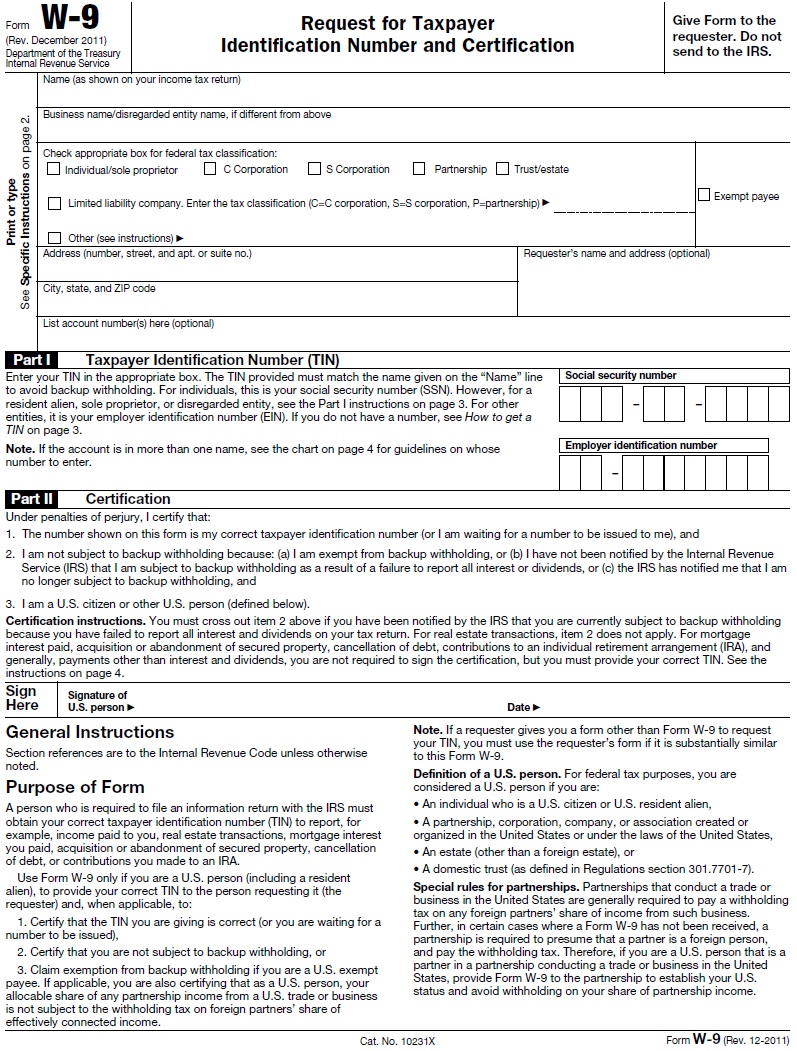
Form W-9 Request for Taxpayer Give Form to the (Rev. December 2011) Identification Number and Certification requester. Do not send to the IRS. Department of the Treasury Internal Revenue Service Name (as shown on your income tax return) 2. Business name/disregarded entity name, if different from above page Check appropriate box for federal tax classification: on Individual/sole proprietor C Corporation S Corporation Partnership Trust/estate type Exempt payee orInstructions Limited liability company. Enter the tax classification (C=C corporation, S=S corporation, P=partnership)▶ Print Other (see instructions)▶ Specific Address (number, street, and apt. or suite no.) Requester’s name and address (optional) City, state, and ZIP code See List account number(s) here (optional) Part I Taxpayer Identification Number (TIN) Enter your TIN in the appropriate box. The TIN provided must match the name given on the “Name” line to avoid backup withholding. For individuals, this is your social security number (SSN). However, for a resident alien, sole proprietor, or disregarded entity, see the Part I instructions on page 3. For other entities, it is your employer identification number (EIN). If you do not have a number, see How to get a TIN on page 3. Social security number – – Note. If the account is in more than one name, see the chart on page 4 for guidelines on whose Employer identification number number to enter. – Part II Certification Under penalties of perjury, I certify that: 1. The number shown on this form is my correct taxpayer identification number (or I am waiting for a number to be issued to me), and 2. I am not subject to backup withholding because: (a) I am exempt from backup withholding, or (b) I have not been notified by the Internal Revenue Service (IRS) that I am subject to backup withholding as a result of a failure to report all interest or dividends, or (c) the IRS has notified me that I am no longer subject to backup withholding, and 3. I am a U.S. citizen or other U.S. person (defined below). Certification instructions. You must cross out item 2 above if you have been notified by the IRS that you are currently subject to backup withholding because you have failed to report all interest and dividends on your tax return. For real estate transactions, item 2 does not apply. For mortgage interest paid, acquisition or abandonment of secured property, cancellation of debt, contributions to an individual retirement arrangement (IRA), and generally, payments other than interest and dividends, you are not required to sign the certification, but you must provide your correct TIN. See the instructions on page 4. Sign Signature of Here U.S. person▶Date▶General Instructions Note. If a requester gives you a form other than Form W-9 to request Section references are to the Internal Revenue Code unless otherwise your TIN, you must use the requester’s form if it is substantially similar to this Form W-9. noted. Definition of a U.S. person. For federal tax purposes, you are Purpose of Form considered a U.S. person if you are: A person who is required to file an information return with the IRS must • An individual who is a U.S. citizen or U.S. resident alien, obtain your correct taxpayer identification number (TIN) to report, for • A partnership, corporation, company, or association created or example, income paid to you, real estate transactions, mortgage interest organized in the United States or under the laws of the United States, you paid, acquisition or abandonment of secured property, cancellation • An estate (other than a foreign estate), or of debt, or contributions you made to an IRA. • A domestic trust (as defined in Regulations section 301.7701-7). Use Form W-9 only if you are a U.S. person (including a resident Special rules for partnerships. Partnerships that conduct a trade or alien), to provide your correct TIN to the person requesting it (the business in the United States are generally required to pay a withholding requester) and, when applicable, to: tax on any foreign partners’ share of income from such business. 1. Certify that the TIN you are giving is correct (or you are waiting for a Further, in certain cases where a Form W-9 has not been received, a number to be issued), partnership is required to presume that a partner is a foreign person, 2. Certify that you are not subject to backup withholding, or and pay the withholding tax. Therefore, if you are a U.S. person that is a 3. Claim exemption from backup withholding if you are a U.S. exempt partner in a partnership conducting a trade or business in the United payee. If applicable, you are also certifying that as a U.S. person, your States, provide Form W-9 to the partnership to establish your U.S. status and avoid withholding on your share of partnership income. allocable share of any partnership income from a U.S. trade or business is not subject to the withholding tax on foreign partners’ share of effectively connected income. Cat. No. 10231X Form W-9 (Rev. 12-2011)
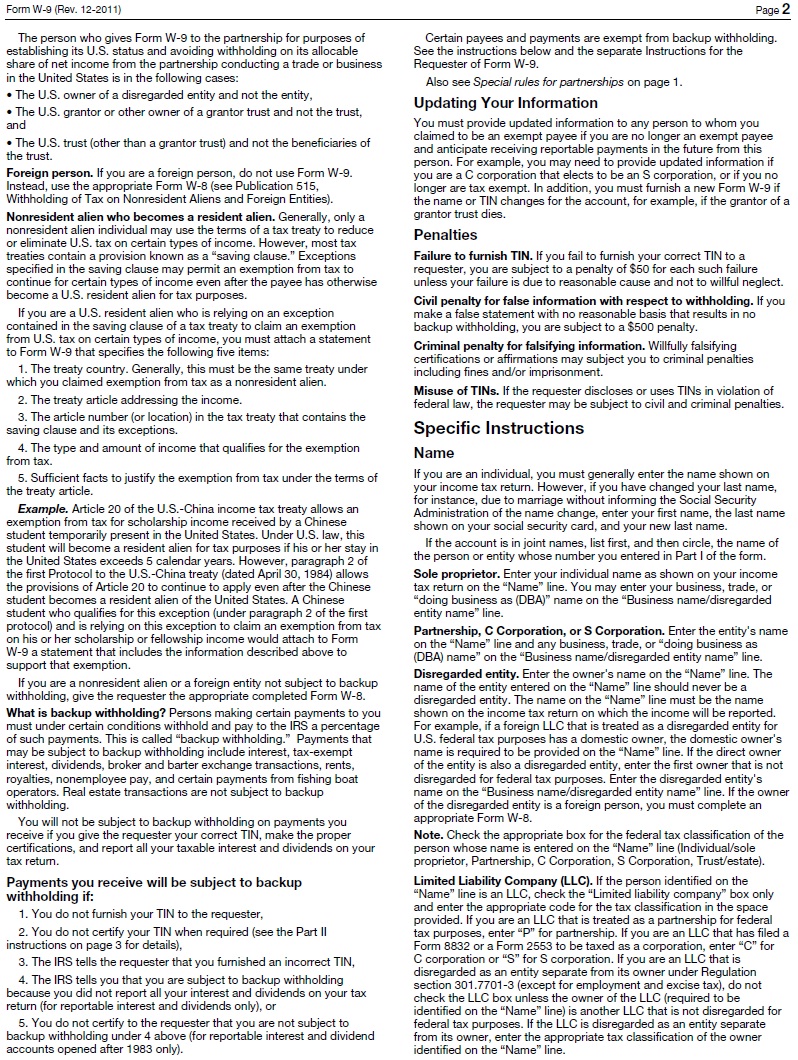
Form W-9 (Rev. 12-2011) Page 2 The person who gives Form W-9 to the partnership for purposes of establishing its U.S. status and avoiding withholding on its allocable share of net income from the partnership conducting a trade or business in the United States is in the following cases: • The U.S. owner of a disregarded entity and not the entity, • The U.S. grantor or other owner of a grantor trust and not the trust, and • The U.S. trust (other than a grantor trust) and not the beneficiaries of the trust. Foreign person. If you are a foreign person, do not use Form W-9. Instead, use the appropriate Form W-8 (see Publication 515, Withholding of Tax on Nonresident Aliens and Foreign Entities). Nonresident alien who becomes a resident alien. Generally, only a nonresident alien individual may use the terms of a tax treaty to reduce or eliminate U.S. tax on certain types of income. However, most tax treaties contain a provision known as a “saving clause.” Exceptions specified in the saving clause may permit an exemption from tax to continue for certain types of income even after the payee has otherwise become a U.S. resident alien for tax purposes. If you are a U.S. resident alien who is relying on an exception contained in the saving clause of a tax treaty to claim an exemption from U.S. tax on certain types of income, you must attach a statement to Form W-9 that specifies the following five items: 1. The treaty country. Generally, this must be the same treaty under which you claimed exemption from tax as a nonresident alien. 2. The treaty article addressing the income. 3. The article number (or location) in the tax treaty that contains the saving clause and its exceptions. 4. The type and amount of income that qualifies for the exemption from tax. 5. Sufficient facts to justify the exemption from tax under the terms of the treaty article. Example. Article 20 of the U.S.-China income tax treaty allows an exemption from tax for scholarship income received by a Chinese student temporarily present in the United States. Under U.S. law, this student will become a resident alien for tax purposes if his or her stay in the United States exceeds 5 calendar years. However, paragraph 2 of the first Protocol to the U.S.-China treaty (dated April 30, 1984) allows the provisions of Article 20 to continue to apply even after the Chinese student becomes a resident alien of the United States. A Chinese student who qualifies for this exception (under paragraph 2 of the first protocol) and is relying on this exception to claim an exemption from tax on his or her scholarship or fellowship income would attach to Form W-9 a statement that includes the information described above to support that exemption. If you are a nonresident alien or a foreign entity not subject to backup withholding, give the requester the appropriate completed Form W-8. What is backup withholding? Persons making certain payments to you must under certain conditions withhold and pay to the IRS a percentage of such payments. This is called “backup withholding.” Payments that may be subject to backup withholding include interest, tax-exempt interest, dividends, broker and barter exchange transactions, rents, royalties, nonemployee pay, and certain payments from fishing boat operators. Real estate transactions are not subject to backup withholding. You will not be subject to backup withholding on payments you receive if you give the requester your correct TIN, make the proper certifications, and report all your taxable interest and dividends on your tax return. Payments you receive will be subject to backup withholding if: 1. You do not furnish your TIN to the requester, 2. You do not certify your TIN when required (see the Part II instructions on page 3 for details), 3. The IRS tells the requester that you furnished an incorrect TIN, 4. The IRS tells you that you are subject to backup withholding because you did not report all your interest and dividends on your tax return (for reportable interest and dividends only), or 5. You do not certify to the requester that you are not subject to backup withholding under 4 above (for reportable interest and dividend accounts opened after 1983 only). Certain payees and payments are exempt from backup withholding. See the instructions below and the separate Instructions for the Requester of Form W-9. Also see Special rules for partnerships on page 1. Updating Your Information You must provide updated information to any person to whom you claimed to be an exempt payee if you are no longer an exempt payee and anticipate receiving reportable payments in the future from this person. For example, you may need to provide updated information if you are a C corporation that elects to be an S corporation, or if you no longer are tax exempt. In addition, you must furnish a new Form W-9 if the name or TIN changes for the account, for example, if the grantor of a grantor trust dies. Penalties Failure to furnish TIN. If you fail to furnish your correct TIN to a requester, you are subject to a penalty of $50 for each such failure unless your failure is due to reasonable cause and not to willful neglect. Civil penalty for false information with respect to withholding. If you make a false statement with no reasonable basis that results in no backup withholding, you are subject to a $500 penalty. Criminal penalty for falsifying information. Willfully falsifying certifications or affirmations may subject you to criminal penalties including fines and/or imprisonment. Misuse of TINs. If the requester discloses or uses TINs in violation of federal law, the requester may be subject to civil and criminal penalties. Specific Instructions Name If you are an individual, you must generally enter the name shown on your income tax return. However, if you have changed your last name, for instance, due to marriage without informing the Social Security Administration of the name change, enter your first name, the last name shown on your social security card, and your new last name. If the account is in joint names, list first, and then circle, the name of the person or entity whose number you entered in Part I of the form. Sole proprietor. Enter your individual name as shown on your income tax return on the “Name” line. You may enter your business, trade, or “doing business as (DBA)” name on the “Business name/disregarded entity name” line. Partnership, C Corporation, or S Corporation. Enter the entity's name on the “Name” line and any business, trade, or “doing business as (DBA) name” on the “Business name/disregarded entity name” line. Disregarded entity. Enter the owner's name on the “Name” line. The name of the entity entered on the “Name” line should never be a disregarded entity. The name on the “Name” line must be the name shown on the income tax return on which the income will be reported. For example, if a foreign LLC that is treated as a disregarded entity for U.S. federal tax purposes has a domestic owner, the domestic owner's name is required to be provided on the “Name” line. If the direct owner of the entity is also a disregarded entity, enter the first owner that is not disregarded for federal tax purposes. Enter the disregarded entity's name on the “Business name/disregarded entity name” line. If the owner of the disregarded entity is a foreign person, you must complete an appropriate Form W-8. Note. Check the appropriate box for the federal tax classification of the person whose name is entered on the “Name” line (Individual/sole proprietor, Partnership, C Corporation, S Corporation, Trust/estate). Limited Liability Company (LLC). If the person identified on the “Name” line is an LLC, check the “Limited liability company” box only and enter the appropriate code for the tax classification in the space provided. If you are an LLC that is treated as a partnership for federal tax purposes, enter “P” for partnership. If you are an LLC that has filed a Form 8832 or a Form 2553 to be taxed as a corporation, enter “C” for C corporation or “S” for S corporation. If you are an LLC that is disregarded as an entity separate from its owner under Regulation section 301.7701-3 (except for employment and excise tax), do not check the LLC box unless the owner of the LLC (required to be identified on the “Name” line) is another LLC that is not disregarded for federal tax purposes. If the LLC is disregarded as an entity separate from its owner, enter the appropriate tax classification of the owner identified on the “Name” line.
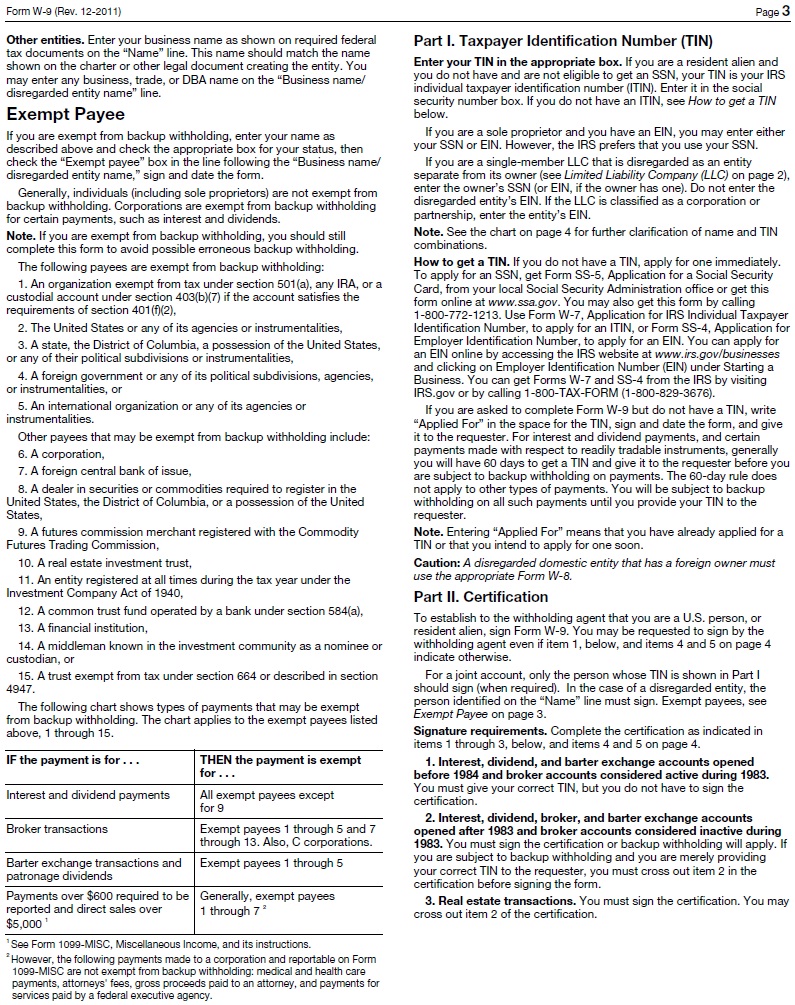
Form W-9 (Rev. 12-2011) Page 3 Other entities. Enter your business name as shown on required federal tax documents on the “Name” line. This name should match the name shown on the charter or other legal document creating the entity. You may enter any business, trade, or DBA name on the “Business name/ disregarded entity name” line. Exempt Payee If you are exempt from backup withholding, enter your name as described above and check the appropriate box for your status, then check the “Exempt payee” box in the line following the “Business name/ disregarded entity name,” sign and date the form. Generally, individuals (including sole proprietors) are not exempt from backup withholding. Corporations are exempt from backup withholding for certain payments, such as interest and dividends. Note. If you are exempt from backup withholding, you should still complete this form to avoid possible erroneous backup withholding. The following payees are exempt from backup withholding: 1. An organization exempt from tax under section 501(a), any IRA, or a custodial account under section 403(b)(7) if the account satisfies the requirements of section 401(f)(2), 2. The United States or any of its agencies or instrumentalities, 3. A state, the District of Columbia, a possession of the United States, or any of their political subdivisions or instrumentalities, 4. A foreign government or any of its political subdivisions, agencies, or instrumentalities, or 5. An international organization or any of its agencies or instrumentalities. Other payees that may be exempt from backup withholding include: 6. A corporation, 7. A foreign central bank of issue, 8. A dealer in securities or commodities required to register in the United States, the District of Columbia, or a possession of the United States, 9. A futures commission merchant registered with the Commodity Futures Trading Commission, 10. A real estate investment trust, 11. An entity registered at all times during the tax year under the Investment Company Act of 1940, 12. A common trust fund operated by a bank under section 584(a), 13. A financial institution, 14. A middleman known in the investment community as a nominee or custodian, or 15. A trust exempt from tax under section 664 or described in section 4947. The following chart shows types of payments that may be exempt from backup withholding. The chart applies to the exempt payees listed above, 1 through 15. IF the payment is for . . . THEN the payment is exempt for . . . Interest and dividend payments All exempt payees except for 9 Broker transactions Exempt payees 1 through 5 and 7 through 13. Also, C corporations. Barter exchange transactions and Exempt payees 1 through 5 patronage dividends Payments over $600 required to be Generally, exempt payees reported and direct sales over 1 through 7 2 $5,000 1 1 See Form 1099-MISC, Miscellaneous Income, and its instructions. 2 However, the following payments made to a corporation and reportable on Form 1099-MISC are not exempt from backup withholding: medical and health care payments, attorneys' fees, gross proceeds paid to an attorney, and payments for services paid by a federal executive agency. Part I. Taxpayer Identification Number (TIN) Enter your TIN in the appropriate box. If you are a resident alien and you do not have and are not eligible to get an SSN, your TIN is your IRS individual taxpayer identification number (ITIN). Enter it in the social security number box. If you do not have an ITIN, see How to get a TIN below. If you are a sole proprietor and you have an EIN, you may enter either your SSN or EIN. However, the IRS prefers that you use your SSN. If you are a single-member LLC that is disregarded as an entity separate from its owner (see Limited Liability Company (LLC) on page 2), enter the owner’s SSN (or EIN, if the owner has one). Do not enter the disregarded entity’s EIN. If the LLC is classified as a corporation or partnership, enter the entity’s EIN. Note. See the chart on page 4 for further clarification of name and TIN combinations. How to get a TIN. If you do not have a TIN, apply for one immediately. To apply for an SSN, get Form SS-5, Application for a Social Security Card, from your local Social Security Administration office or get this form online at www.ssa.gov. You may also get this form by calling 1-800-772-1213. Use Form W-7, Application for IRS Individual Taxpayer Identification Number, to apply for an ITIN, or Form SS-4, Application for Employer Identification Number, to apply for an EIN. You can apply for an EIN online by accessing the IRS website at www.irs.gov/businesses and clicking on Employer Identification Number (EIN) under Starting a Business. You can get Forms W-7 and SS-4 from the IRS by visiting IRS.gov or by calling 1-800-TAX-FORM (1-800-829-3676). If you are asked to complete Form W-9 but do not have a TIN, write “Applied For” in the space for the TIN, sign and date the form, and give it to the requester. For interest and dividend payments, and certain payments made with respect to readily tradable instruments, generally you will have 60 days to get a TIN and give it to the requester before you are subject to backup withholding on payments. The 60-day rule does not apply to other types of payments. You will be subject to backup withholding on all such payments until you provide your TIN to the requester. Note. Entering “Applied For” means that you have already applied for a TIN or that you intend to apply for one soon. Caution: A disregarded domestic entity that has a foreign owner must use the appropriate Form W-8. Part II. Certification To establish to the withholding agent that you are a U.S. person, or resident alien, sign Form W-9. You may be requested to sign by the withholding agent even if item 1, below, and items 4 and 5 on page 4 indicate otherwise. For a joint account, only the person whose TIN is shown in Part I should sign (when required). In the case of a disregarded entity, the person identified on the “Name” line must sign. Exempt payees, see Exempt Payee on page 3. Signature requirements. Complete the certification as indicated in items 1 through 3, below, and items 4 and 5 on page 4. 1. Interest, dividend, and barter exchange accounts opened before 1984 and broker accounts considered active during 1983. You must give your correct TIN, but you do not have to sign the certification. 2. Interest, dividend, broker, and barter exchange accounts opened after 1983 and broker accounts considered inactive during 1983. You must sign the certification or backup withholding will apply. If you are subject to backup withholding and you are merely providing your correct TIN to the requester, you must cross out item 2 in the certification before signing the form. 3. Real estate transactions. You must sign the certification. You may cross out item 2 of the certification.
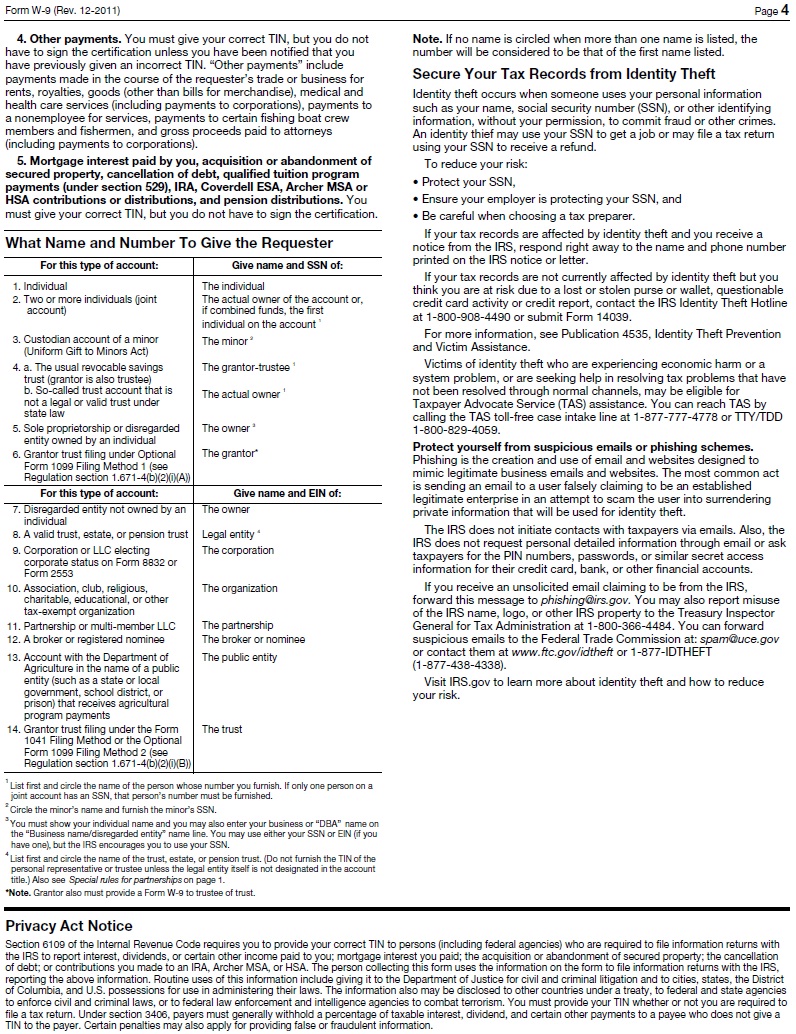
Form W-9 (Rev. 12-2011) Page 4 4. Other payments. You must give your correct TIN, but you do not have to sign the certification unless you have been notified that you have previously given an incorrect TIN. “Other payments” include payments made in the course of the requester’s trade or business for rents, royalties, goods (other than bills for merchandise), medical and health care services (including payments to corporations), payments to a nonemployee for services, payments to certain fishing boat crew members and fishermen, and gross proceeds paid to attorneys (including payments to corporations). 5. Mortgage interest paid by you, acquisition or abandonment of secured property, cancellation of debt, qualified tuition program payments (under section 529), IRA, Coverdell ESA, Archer MSA or HSA contributions or distributions, and pension distributions. You must give your correct TIN, but you do not have to sign the certification. What Name and Number To Give the Requester For this type of account: Give name and SSN of: 1. Individual The individual 2. Two or more individuals (joint The actual owner of the account or, account) if combined funds, the first individual on the account 1 3. Custodian account of a minor The minor 2 (Uniform Gift to Minors Act) 4. a. The usual revocable savings The grantor-trustee 1 trust (grantor is also trustee) b. So-called trust account that is The actual owner 1 not a legal or valid trust under state law 5. Sole proprietorship or disregarded The owner 3 entity owned by an individual 6. Grantor trust filing under Optional The grantor* Form 1099 Filing Method 1 (see Regulation section 1.671-4(b)(2)(i)(A)) For this type of account: Give name and EIN of: 7. Disregarded entity not owned by an The owner individual 8. A valid trust, estate, or pension trust Legal entity 4 9. Corporation or LLC electing The corporation corporate status on Form 8832 or Form 2553 10. Association, club, religious, The organization charitable, educational, or other tax-exempt organization 11. Partnership or multi-member LLC The partnership 12. A broker or registered nominee The broker or nominee 13. Account with the Department of The public entity Agriculture in the name of a public entity (such as a state or local government, school district, or prison) that receives agricultural program payments 14. Grantor trust filing under the Form The trust 1041 Filing Method or the Optional Form 1099 Filing Method 2 (see Regulation section 1.671-4(b)(2)(i)(B)) 1 List first and circle the name of the person whose number you furnish. If only one person on a joint account has an SSN, that person’s number must be furnished. 2 Circle the minor’s name and furnish the minor’s SSN. 3 You must show your individual name and you may also enter your business or “DBA” name on the “Business name/disregarded entity” name line. You may use either your SSN or EIN (if you have one), but the IRS encourages you to use your SSN. 4 List first and circle the name of the trust, estate, or pension trust. (Do not furnish the TIN of the personal representative or trustee unless the legal entity itself is not designated in the account title.) Also see Special rules for partnerships on page 1. *Note. Grantor also must provide a Form W-9 to trustee of trust. Note. If no name is circled when more than one name is listed, the number will be considered to be that of the first name listed. Secure Your Tax Records from Identity Theft Identity theft occurs when someone uses your personal information such as your name, social security number (SSN), or other identifying information, without your permission, to commit fraud or other crimes. An identity thief may use your SSN to get a job or may file a tax return using your SSN to receive a refund. To reduce your risk: • Protect your SSN, • Ensure your employer is protecting your SSN, and • Be careful when choosing a tax preparer. If your tax records are affected by identity theft and you receive a notice from the IRS, respond right away to the name and phone number printed on the IRS notice or letter. If your tax records are not currently affected by identity theft but you think you are at risk due to a lost or stolen purse or wallet, questionable credit card activity or credit report, contact the IRS Identity Theft Hotline at 1-800-908-4490 or submit Form 14039. For more information, see Publication 4535, Identity Theft Prevention and Victim Assistance. Victims of identity theft who are experiencing economic harm or a system problem, or are seeking help in resolving tax problems that have not been resolved through normal channels, may be eligible for Taxpayer Advocate Service (TAS) assistance. You can reach TAS by calling the TAS toll-free case intake line at 1-877-777-4778 or TTY/TDD 1-800-829-4059. Protect yourself from suspicious emails or phishing schemes. Phishing is the creation and use of email and websites designed to mimic legitimate business emails and websites. The most common act is sending an email to a user falsely claiming to be an established legitimate enterprise in an attempt to scam the user into surrendering private information that will be used for identity theft. The IRS does not initiate contacts with taxpayers via emails. Also, the IRS does not request personal detailed information through email or ask taxpayers for the PIN numbers, passwords, or similar secret access information for their credit card, bank, or other financial accounts. If you receive an unsolicited email claiming to be from the IRS, forward this message to phishing@irs.gov. You may also report misuse of the IRS name, logo, or other IRS property to the Treasury Inspector General for Tax Administration at 1-800-366-4484. You can forward suspicious emails to the Federal Trade Commission at: spam@uce.gov or contact them at www.ftc.gov/idtheft or 1-877-IDTHEFT (1-877-438-4338). Visit IRS.gov to learn more about identity theft and how to reduce your risk. Privacy Act Notice Section 6109 of the Internal Revenue Code requires you to provide your correct TIN to persons (including federal agencies) who are required to file information returns with the IRS to report interest, dividends, or certain other income paid to you; mortgage interest you paid; the acquisition or abandonment of secured property; the cancellation of debt; or contributions you made to an IRA, Archer MSA, or HSA. The person collecting this form uses the information on the form to file information returns with the IRS, reporting the above information. Routine uses of this information include giving it to the Department of Justice for civil and criminal litigation and to cities, states, the District of Columbia, and U.S. possessions for use in administering their laws. The information also may be disclosed to other countries under a treaty, to federal and state agencies to enforce civil and criminal laws, or to federal law enforcement and intelligence agencies to combat terrorism. You must provide your TIN whether or not you are required to file a tax return. Under section 3406, payers must generally withhold a percentage of taxable interest, dividend, and certain other payments to a payee who does not give a TIN to the payer. Certain penalties may also apply for providing false or fraudulent information.

BDCA BUSINESS DEVELOPMENT CORPORATION OF AMERICA LET TER OF TRANSMIT TAL PURSUANT TO THE OFFER TO PURCHASE DATED OCTOBER 22ND, 2013 INSTRUCTIONS TO LETTER OF TRANSMITTAL FORMING PART OF TERMS AND CONDITIONS OF THIS LETTER OF TRANSMITTAL 1. Guarantee of Signatures. Signatures on this Letter of Transmittal must be guaranteed in Box 3 in accordance with Rule 17Ad-15 (promulgated under the Securities Exchange Act of 1934, as amended) by an eligible guarantor institution which is a participant in a stock transfer association recognized program, such as a firm that is a member of a registered national securities exchange, a member of the Financial Industry Regulatory Authority, by a commercial bank or trust company having an office or correspondent in the United States or by an international bank, securities dealer, securities broker or other financial institution licensed to do business in its home country (an “Eligible Institution”) unless (i) the Letter of Transmittal is signed by the registered holder(s) of the Shares tendered therewith and such holder(s) have not completed Box 1 “Special Registration and Payment Instructions” above or (ii) the Shares described above are delivered for the account of an Eligible Institution. IN ALL OTHER CASES ALL SIGNATURES MUST BE GUARANTEED BY AN ELIGIBLE INSTITUTION. 2. Delivery of Letter of Transmittal. This Letter of Transmittal, properly completed and duly executed, should be sent by mail or courier or delivered by hand to the Company in each case at the address set forth on the front page of this Letter of Transmittal, in order to make an effective tender. A properly completed and duly executed Letter of Transmittal must be received by the Company at the address set forth on the front page of this Letter of Transmittal by 12:00 Midnight, Eastern Time, on November 21, 2013, unless the Offer is extended. The Purchase Price will be paid and issued in exchange for the Shares tendered and accepted for purchase by the Company pursuant to the Offer to Purchase in all cases only after receipt by the Company of a properly completed and duly executed Letter of Transmittal. The method of delivery of all documents is at the option and risk of the undersigned and the delivery will be deemed made only when actually received. If delivery is by mail, registered mail with return receipt requested, properly insured, is recommended. 3. Signatures on this Letter of Transmittal, Powers of Attorney and Endorsements. (a) If this Letter of Transmittal is signed by the registered holder(s) of the Shares to be tendered, the signature(s) of the holder on this Letter of Transmittal must correspond exactly with the name(s) on the subscription agreement accepted by the Company in connection with the purchase of the Shares, unless such Shares have been transferred by the registered holder(s), in which event this Letter of Transmittal should be signed in exactly the same form as the name of the last transferee indicated on the stock ledger maintained in book-entry form by American National Stock Transfer, LLC, the Company’s transfer agent. (b) If any Shares tendered with this Letter of Transmittal are owned of record by two or more joint owners, all such owners must sign this Letter of Transmittal. (c) If this Letter of Transmittal is signed by a trustee, executor, administrator, guardian, attorney-in-fact, officer of a corporation or other person acting in a fiduciary or representative capacity, such person must so indicate when signing, and proper evidence satisfactory to the Company of their authority to so act must be submitted. (d) If this Letter of Transmittal is signed by a person other than the registered holder(s) of the Shares listed, the Letter of Transmittal must be endorsed or accompanied by appropriate stock powers, in either case signed exactly as the name(s) of the registered holder(s) appear(s) on the subscription agreement accepted by the Company in connection with the purchase of the Shares. Signatures must be guaranteed in Box 3 by an Eligible Institution (unless signed by an Eligible Institution). 4. Withholding. The Company is entitled to deduct and withhold from the Purchase Price otherwise payable to any holder of Shares whose Shares are accepted for purchase by the Company any amounts that the Company is required to deduct and withhold with respect to the making of such payment under the Internal Revenue Code of 1986, as amended (the “Code”), or any provision of state, local or foreign tax law. To the extent that amounts are withheld, the withheld amounts shall be treated for all purposes as having been paid and issued to the holder of Shares in respect of which such deduction and withholding was made. 5. Transfer Taxes. The Company will pay any transfer taxes payable on the transfer to it of Shares purchased pursuant to the Offer; provided, however, that if payment of the Purchase Price is to be made to, or (in the circumstances permitted by the Offer) unpurchased Shares are to be registered in the name(s) of, any person(s) other than the registered owner(s), the amount of any transfer taxes (whether imposed on the registered owner(s) or such other person(s)) payable on account of the transfer to such person(s) will be deducted from the Purchase Price unless satisfactory evidence of the payment of such taxes, or exemption therefrom, is submitted herewith. 6. Special Registration and Payment Instructions and Special Delivery Instructions. If the Purchase Price is to be paid and issued to a person other than the person(s) signing the Letter of Transmittal, then Box 1 must be completed. If the Purchase Price is to be mailed or wired to someone other than the person(s) signing the Letter of Transmittal, or to the person(s) signing the Letter of Transmittal at an address other than that shown above, then Box 1 must be completed.
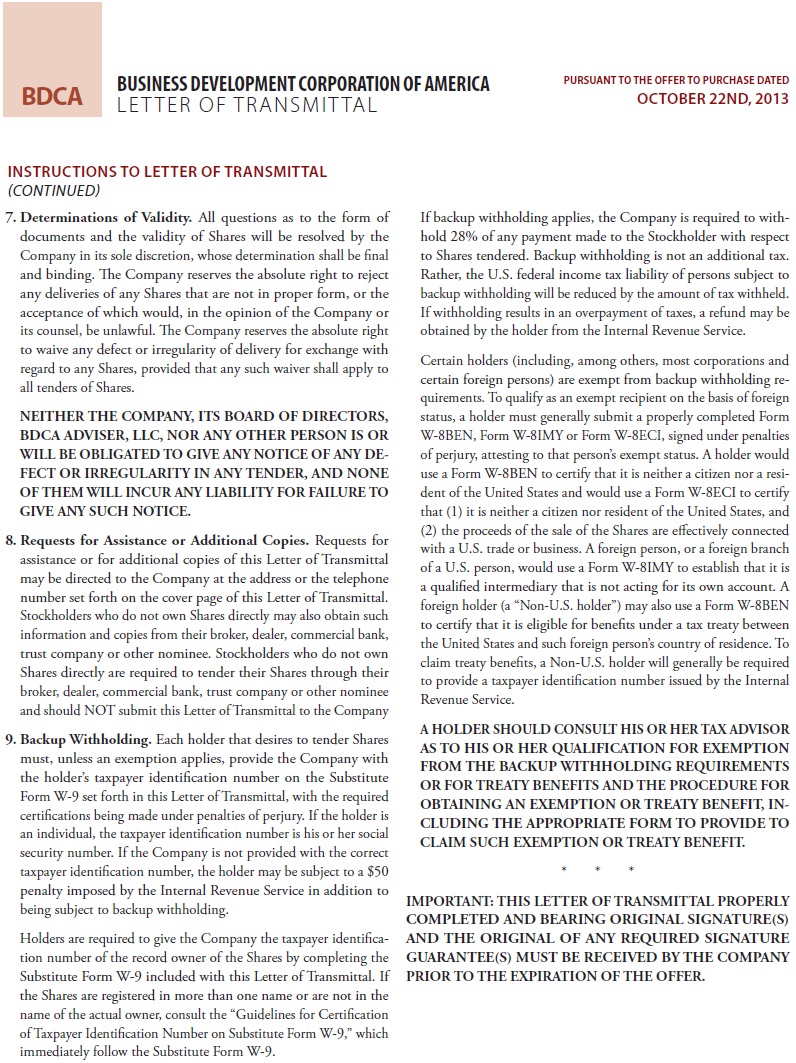
BDCA BUSINESS DEVELOPMENT CORPORATION OF AMERICA LET TER OF TRANSMIT TAL PURSUANT TO THE OFFER TO PURCHASE DATED OCTOBER 22ND, 2013 INSTRUCTIONS TO LETTER OF TRANSMITTAL (CONTINUED) 7. Determinations of Validity. All questions as to the form of documents and the validity of Shares will be resolved by the Company in its sole discretion, whose determination shall be final and binding. The Company reserves the absolute right to reject any deliveries of any Shares that are not in proper form, or the acceptance of which would, in the opinion of the Company or its counsel, be unlawful. The Company reserves the absolute right to waive any defect or irregularity of delivery for exchange with regard to any Shares, provided that any such waiver shall apply to all tenders of Shares. NEITHER THE COMPANY, ITS BOARD OF DIRECTORS, BDCA ADVISER, LLC, NOR ANY OTHER PERSON IS OR WILL BE OBLIGATED TO GIVE ANY NOTICE OF ANY DE-FECT OR IRREGULARITY IN ANY TENDER, AND NONE OF THEM WILL INCUR ANY LIABILITY FOR FAILURE TO GIVE ANY SUCH NOTICE. 8. Requests for Assistance or Additional Copies. Requests for assistance or for additional copies of this Letter of Transmittal may be directed to the Company at the address or the telephone number set forth on the cover page of this Letter of Transmittal. Stockholders who do not own Shares directly may also obtain such information and copies from their broker, dealer, commercial bank, trust company or other nominee. Stockholders who do not own Shares directly are required to tender their Shares through their broker, dealer, commercial bank, trust company or other nominee and should NOT submit this Letter of Transmittal to the Company 9. Backup Withholding. Each holder that desires to tender Shares must, unless an exemption applies, provide the Company with the holder’s taxpayer identification number on the Substitute Form W-9 set forth in this Letter of Transmittal, with the required certifications being made under penalties of perjury. If the holder is an individual, the taxpayer identification number is his or her social security number. If the Company is not provided with the correct taxpayer identification number, the holder may be subject to a $50 penalty imposed by the Internal Revenue Service in addition to being subject to backup withholding. Holders are required to give the Company the taxpayer identifica-tion number of the record owner of the Shares by completing the Substitute Form W-9 included with this Letter of Transmittal. If the Shares are registered in more than one name or are not in the name of the actual owner, consult the “Guidelines for Certification of Taxpayer Identification Number on Substitute Form W-9,” which immediately follow the Substitute Form W-9. If backup withholding applies, the Company is required to with-hold 28% of any payment made to the Stockholder with respect to Shares tendered. Backup withholding is not an additional tax. Rather, the U.S. federal income tax liability of persons subject to backup withholding will be reduced by the amount of tax withheld. If withholding results in an overpayment of taxes, a refund may be obtained by the holder from the Internal Revenue Service. Certain holders (including, among others, most corporations and certain foreign persons) are exempt from backup withholding re-quirements. To qualify as an exempt recipient on the basis of foreign status, a holder must generally submit a properly completed Form W-8BEN, Form W-8IMY or Form W-8ECI, signed under penalties of perjury, attesting to that person’s exempt status. A holder would use a Form W-8BEN to certify that it is neither a citizen nor a resi-dent of the United States and would use a Form W-8ECI to certify that (1) it is neither a citizen nor resident of the United States, and (2) the proceeds of the sale of the Shares are effectively connected with a U.S. trade or business. A foreign person, or a foreign branch of a U.S. person, would use a Form W-8IMY to establish that it is a qualified intermediary that is not acting for its own account. A foreign holder (a “Non-U.S. holder”) may also use a Form W-8BEN to certify that it is eligible for benefits under a tax treaty between the United States and such foreign person’s country of residence. To claim treaty benefits, a Non-U.S. holder will generally be required to provide a taxpayer identification number issued by the Internal Revenue Service. A HOLDER SHOULD CONSULT HIS OR HER TAX ADVISOR AS TO HIS OR HER QUALIFICATION FOR EXEMPTION FROM THE BACKUP WITHHOLDING REQUIREMENTS OR FOR TREATY BENEFITS AND THE PROCEDURE FOR OBTAINING AN EXEMPTION OR TREATY BENEFIT, IN-CLUDING THE APPROPRIATE FORM TO PROVIDE TO CLAIM SUCH EXEMPTION OR TREATY BENEFIT. * * * IMPORTANT: THIS LETTER OF TRANSMITTAL PROPERLY COMPLETED AND BEARING ORIGINAL SIGNATURE(S) AND THE ORIGINAL OF ANY REQUIRED SIGNATURE GUARANTEE(S) MUST BE RECEIVED BY THE COMPANY PRIOR TO THE EXPIRATION OF THE OFFER.








